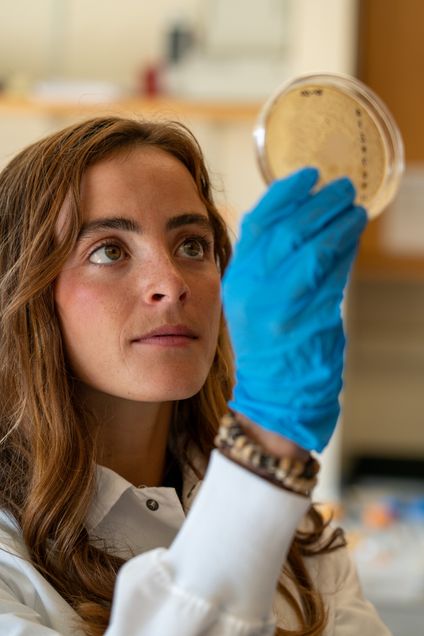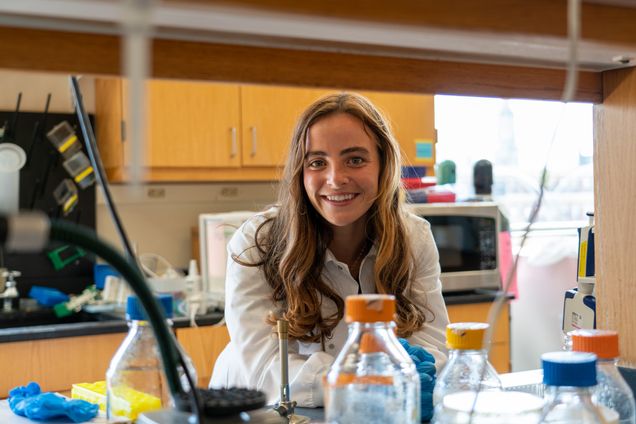Neila Gross: Investigating Antibiotic Resistance
By Mandile Mpofu
In August 2022, Neila Gross summited Mount Kilimanjaro. It was a grueling journey that took her five and a half days to make her way up the highest peak on the African continent and one and a half days to make her way down. On the first day, as she looked across the desolate plane where the mountain stood, uncertainty set in when she realized how far she had to go. And when she looked up and noticed that the mountain’s summit was obscured by the clouds because of its height, one thought took over: “You can’t do this.” But she set aside her self-doubts and, many pitstops and thousands of feet later, she made it to the top.

“It taught me a huge lesson. I feel like when you try and you just go for those big things, whether you fail or you succeed, it can always teach you a huge lesson,” Gross said. “If you don’t reach the summit, at least you tried.”
She applies this philosophy to everything she does, including her academic studies as a doctoral candidate in Materials Science and Engineering. Gross works in a laboratory with Muhammad Zaman, a professor of biomedical engineering, whose work focuses on environmental factors that influence antibiotic resistance and the public health outcomes of these endemics in refugee camps and informal settlements located in low-to-middle-income countries. It was his encouragement that pushed Gross to apply for a prestigious fellowship, which she received.
The National Science Foundation (NSF) Graduate Research Fellowship Program (GRFP), which Gross was awarded in the 2022-2023 academic year, is a grant that “supports outstanding graduate students who have demonstrated the potential to be high achieving scientists and engineers,” according to its website. The fellowship covers Gross’ stipend over three years, offering financial assistance to conduct her research.
In Zaman’s laboratory, Gross researchers how materials, such as heavy metals or microplastics, within wastewater affect antibiotic resistance in bacteria, an idea that emerged from a collaborative Zoom call with her peers and professor.
“I love the support that I have from what feels like all corners of the engineering divisions. There’s support everywhere, wherever you need it,” she said. “I can’t wait to be on the giving end of that, just because it has helped me so much.”
Antibiotic resistance occurs when bacteria are repeatedly exposed to small amounts of antibiotics to which they eventually become resistant via evolutionary processes. In environments such as wastewater where bacteria grow, small doses of antibiotics are introduced through daily human activities, Gross explained. For example, when people take antibiotics, the entire dose is not absorbed into the bloodstream. The residue can then enter wastewater via human excrement.

Actions as routine as washing one’s hands after using antimicrobial sprays can also introduce small quantities of antibiotics into wastewater. While these doses on their own are somewhat inconsequential, an accumulation of them could be concentrated enough to have a notable effect on the bacteria, especially when microplastics are added to the mix.
While Gross is not yet quite sure to what extent microplastics impact antibiotic resistance in bacteria, she has a theory. Bacteria grow in two modes: planktonic and biofilms. Planktonic bacteria are free-living, one-cell bacteria that float in liquids and are found in microbiology labs. Bacteria biofilms are formed when bacteria aggregate into a biofilm, a coagulation that plays a role in protecting the bacteria community. In layman’s terms, Gross describes biofilms as “a slimy goop of stuff” or “armor for bacteria.” Microplastics serve as a substrate upon which biofilms can grow and create an opportunity for the development of what Gross calls “a very powerful armor” that can hinder antibiotic action.
She investigates the types of microplastics found in wastewater — their chemical composition, shape, and size — and their effects on bacteria such as E. coli. She also hopes to do the same analysis on the bacteria strain that causes cholera to determine if the increased presence of microplastics worsens mortality rates in areas prone to the disease.
“I have so many ideas, actually. I don’t know how I’ll ever fit them in the amount of time that I have,” she said. “But that’s the great thing about this NSF grant is that we can now pursue kind of whatever we want.”

The best case outcome of her research, Gross said, would be to create a “robust model that’s been tested and can potentially help to inform government policy” in the various countries she has conducted research, especially given the severity of antibiotic resistance and the urgent need for action. She said the intake of more aggressive antibiotics created because of increased antibiotic resistance can have “debilitating side effects” and can lead to multidrug-resistant bacteria, those that are resistant to several antibiotics.
Gross first traveled to the African continent in an act of teenage rebellion. Inspired by her brother’s trip to Ghana and despite her parents’ protests, she went to South Africa— a far cry from her California farm upbringing — fresh out of high school to find “meaning and purpose” while volunteering. During her time in Capricorn, a township in the south of the country, she taught mathematics and, after school, gave surfing lessons.
On her trip, she found the purpose she was looking for — it was not completely clear, but she knew she wanted to continue to help people in socioeconomically disadvantaged countries. She also realized that while she was a scientist, she loved to teach. Gross returned to Africa several times after that to teach and volunteer, finding herself in countries she said now feel like home.
As an undergraduate student, she taught at a village in Uganda, where she helped to start a volunteer organization. In her senior year, she spent months in Rwanda volunteering and teaching, sometimes organizing fundraisers for resources for the school, while working at the Rwandan Biomedical Center where she studied the genetic transfer of stress from mother to child, based on research around the Rwandan Genocide.
“I wanted to make a positive impact in the world because I grew up with such privilege and freedom,” she said. “My parents always say that privilege isn’t a problem unless you don’t do something good with it.”
Gross knows that being a woman in STEM isn’t easy, in the U.S. and other parts of the world. Women are “taught to doubt themselves a lot,” especially when they fail to live up to the unattainable standards of perfection set for them.
“One of my main life goals is to develop a program to get more young girls into STEM, specifically math and engineering,” she said. “Because we can be pretty good at it when we are given the chance.”
In the meantime, she has continued to mentor three young, Ugandan women who are in high school who she met during her time there. She taught them the lesson she learned on Mount Kilimanjaro: just keep trying. Gross is set to graduate in 2026. Until then, she said her field research will likely take her all over the world.